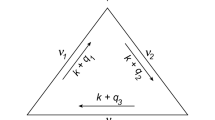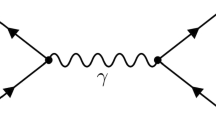Abstract
The consistency of loop regularization (LORE) method is explored in multiloop calculations. A key concept of the LORE method is the introduction of irreducible loop integrals (ILIs) which are evaluated from the Feynman diagrams by adopting the Feynman parametrization and ultraviolet-divergence-preserving (UVDP) parametrization. It is then inevitable for the ILIs to encounter the divergences in the UVDP parameter space due to the generic overlapping divergences in the four-dimensional momentum space. By computing the so-called αβγ integrals arising from two-loop Feynman diagrams, we show how to deal with the divergences in the parameter space with the LORE method. By identifying the divergences in the UVDP parameter space to those in the subdiagrams, we arrive at the Bjorken–Drell analogy between Feynman diagrams and electrical circuits. The UVDP parameters are shown to correspond to the conductance or resistance in the electrical circuits, and the divergence in Feynman diagrams is ascribed to the infinite conductance or zero resistance. In particular, the sets of conditions required to eliminate the overlapping momentum integrals for obtaining the ILIs are found to be associated with the conservations of electric voltages, and the momentum conservations correspond to the conservations of electrical currents, which are known as the Kirchhoff laws in the electrical circuits analogy. As a practical application, we carry out a detailed calculation for one-loop and two-loop Feynman diagrams in the massive scalar ϕ 4 theory, which enables us to obtain the well-known logarithmic running of the coupling constant and the consistent power-law running of the scalar mass at two-loop level. Especially, we present an explicit demonstration on the general procedure of applying the LORE method to the multiloop calculations of Feynman diagrams when merging with the advantage of Bjorken–Drell’s circuit analogy.
















Similar content being viewed by others
Notes
For a critical review, see [2].
The first inequality comes from the fact that in order that the expression is generic, we need to consider every type of internal momentum combinations in the denominator, such as \((l_{j}^{\prime }-p_{j})^{2},(l_{i}^{\prime }+l_{i+1}^{\prime }-p_{i(i+1)})^{2},\ldots,(l_{1}^{\prime }+l_{2}^{\prime }+\cdots +l_{k}^{\prime }-p_{12\ldots k})^{2}\). The total number of the combinations is \(k+(k-1)+\cdots +1=\frac{k(k+1)}{2}\). If all the types of combination appear in the denominator, then the inequality holds.
References
G. ’t Hooft, M.J.G. Veltman, Nucl. Phys. B 44, 189 (1972)
G. Bonneau, PAR-LPTHE-88-52a, May 23, 1989, unpublished
Y.L. Wu, Int. J. Mod. Phys. A 18, 5363 (2003). arXiv:hep-th/0209021
Y.L. Wu, Mod. Phys. Lett. A 19, 2191 (2004). arXiv:hep-th/0311082
J.W. Cui, Y.L. Wu, Int. J. Mod. Phys. A 23, 2861 (2008). arXiv:0801.2199 [hep-ph]
J.W. Cui, Y. Tang, Y.L. Wu, Phys. Rev. D 79, 125008 (2009). arXiv:0812.0892 [hep-ph]
Y.L. Ma, Y.L. Wu, Int. J. Mod. Phys. A 21, 6383 (2006). arXiv:hep-ph/0509083
Y.L. Ma, Y.L. Wu, Phys. Lett. B 647, 427 (2007). arXiv:hep-ph/0611199
J.W. Cui, Y.L. Ma, Y.L. Wu, Phys. Rev. D 84, 025020 (2011). arXiv:1103.2026 [hep-ph]
Y.B. Dai, Y.L. Wu, Eur. Phys. J. C 39, S1 (2004). arXiv:hep-ph/0304075
D. Huang, Y.L. Wu, e-Print. arXiv:1110.4491 [hep-ph]
Y. Tang, Y.L. Wu, Commun. Theor. Phys. 54, 1040 (2010). arXiv:0807.0331 [hep-ph]
Y. Tang, Y.L. Wu, Commun. Theor. Phys. 57, 629 (2012). arXiv:1012.0626 [hep-ph]
Y. Tang, Y.L. Wu, J. High Energy Phys. 1111, 073 (2011). arXiv:1109.4001 [hep-ph]
J. Bjorken, S. Drell, Relativistic Quantum Fields (McGraw-Hill, New York, 1965), p. 220. 396 p.
M.E. Peskin, D.V. Schroeder, An Introduction to Quantum Field Theory (Addison-Wesley, Reading, 1995), 842 p.
C. Itzykson, J.B. Zuber, Quantum Field Theory. International Series in Pure and Applied Physics (McGraw-Hill, New York, 1980), 705 p.
E. Brezin, J.C. Le Guillou, J. Zinn-Justin, Phys. Rev. D 9, 1121 (1974)
K.G. Chetyrkin, S.G. Gorishny, S.A. Larin, F.V. Tkachov, Phys. Lett. B 132, 351 (1983)
F.M. Dittes, Yu.A. Kubyshin, O.V. Tarasov, Theor. Math. Phys. 37, 879 (1979). Teor. Mat. Fiz. 37, 66 (1978)
D.I. Kazakov, O.V. Tarasov, A.A. Vladimirov, JINR-E2-12249. Dubna, JINR. Feb 1979. 23 pp. Published in Sov. Phys. JETP 50, 521 (1979), Zh. Eksp. Teor. Fiz. 77, 1035 (1979)
D. Huang, Y.L. Wu, in preparation
D. Huang, Y.L. Wu, work in progress
Acknowledgements
The authors would like to thank J.W. Cui and Y.B. Yang for useful discussions and L.F. Li for helpfully reading the manuscript. This work was supported in part by the National Science Foundation of China (NSFC) under Grant #Nos. 10821504, 10975170 and the key project of the Chinese Academy of Science.
Author information
Authors and Affiliations
Corresponding author
Appendix: Useful formulas in UV divergence preserving (UVDP)
Appendix: Useful formulas in UV divergence preserving (UVDP)
The introduction of UVDP parameters is to combine the various denominators propagating factors, whose utility is similar to Feynman parameters. The motivation to introduce a new UVDP parametrization method is to transform a divergent integral in the UVDP parameter space into a ILI-like divergent one, the object regularized by the LORE method. The simplest case is to combine only two factors in the denominator by using the identity:

If one of the factors has more than one power, we can differentiate with respect to A or B to get

The general identity for more than two factors is

An even more general form can be derived:

Alternatively, we may also take another more useful form for the case of two factors by just integrating out one of the parameters u and v by using the delta function, which has been adopted in [3]:
but this form cannot be generalized to the more general case easily.
From the general identity Eq. (A.1), we notice that the relation of the UVDP parameters v i to Feynman parameters x i is
This identification allows us to transform a divergent integral with Feynman parameters into the one with UVDP parameters, which can be further transformed into a ILI-like integral by introducing a free mass scale and being regularized in the framework of the LORE method. Such a trick is discussed in Eq. (32).
Rights and permissions
About this article
Cite this article
Huang, D., Wu, YL. Consistency and advantage of loop regularization method merging with Bjorken–Drell’s analogy between Feynman diagrams and electrical circuits. Eur. Phys. J. C 72, 2066 (2012). https://doi.org/10.1140/epjc/s10052-012-2066-2
Received:
Revised:
Published:
DOI: https://doi.org/10.1140/epjc/s10052-012-2066-2




